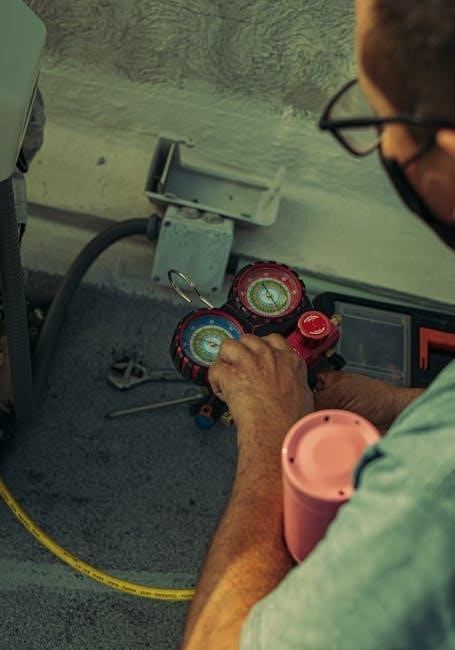To troubleshoot ResMed AirSense 10 issues, visit the official website for guidance and support, using online resources and user manuals for effective problem-solving and maintenance techniques always.
General Troubleshooting Information
When experiencing issues with the ResMed AirSense 10, it is essential to refer to the user manual and online resources for guidance and support. The official website provides a comprehensive troubleshooting guide, including step-by-step instructions and videos to help resolve common problems. By following these guidelines, users can identify and fix issues quickly and efficiently, minimizing downtime and ensuring continuous therapy. Additionally, the website offers a list of frequently asked questions and answers, covering topics such as device setup, operation, and maintenance. Users can also contact ResMed customer support for further assistance and guidance. It is crucial to follow the recommended troubleshooting procedures to avoid damaging the device or compromising therapy. By taking a systematic approach to troubleshooting, users can ensure optimal performance and effectiveness of their ResMed AirSense 10 device, and maintain a healthy and restful sleep pattern, using online resources and user manuals for effective problem-solving.

Common Problems with ResMed AirSense 10
Users often experience issues with air leaks and device settings, requiring troubleshooting and maintenance to ensure optimal performance always.
Device Still Blowing Air After Therapy
If the ResMed AirSense 10 device continues to blow air after therapy, it may indicate a problem with the device’s settings or a malfunction. To troubleshoot this issue, users can try checking the device’s settings to ensure that they are correctly configured. Additionally, users can try restarting the device by disconnecting and reconnecting the power cord. It is also recommended to check the air filter and tubing for any blockages or kinks that may be causing the issue. If the problem persists, it is recommended to contact a healthcare professional or the manufacturer’s support team for further assistance. They can provide guidance on how to resolve the issue and ensure that the device is functioning properly. By following these steps, users can troubleshoot the issue and ensure that their device is working correctly, providing effective therapy and improving their overall sleep quality. Users can find more information on the official ResMed website.
Troubleshooting Steps for Power Problems
When experiencing power problems with the ResMed AirSense 10, there are several troubleshooting steps that can be taken. First, users should check the power cord to ensure it is properly connected to both the device and the power outlet. Next, users can try plugging the device into a different outlet to rule out any issues with the electrical supply. Additionally, users can check the device’s power button to ensure it is functioning correctly. If the issue persists, users can try resetting the device by pressing and holding the power button for a few seconds. It is also recommended to check the device’s battery, if applicable, to ensure it is fully charged. By following these steps, users can troubleshoot power problems and get their device up and running again. The ResMed website provides a comprehensive guide to troubleshooting power issues, which can be accessed by visiting their website and navigating to the support section.

ResMed AirSense 10 User Guide
Visit the official ResMed website for a comprehensive user guide and instructional videos always available online.
Understanding the Device Settings
To ensure proper use of the ResMed AirSense 10, it is essential to understand the device settings. The device has various settings that can be adjusted to suit individual needs, including ramp time, pressure relief, and humidity levels. The user manual provides detailed information on how to navigate and adjust these settings. By familiarizing yourself with the device settings, you can optimize your therapy and improve overall comfort. The device’s settings can be accessed through the touchscreen interface, making it easy to adjust and customize your therapy. Additionally, the device’s automatic adjustment features can help to ensure that you receive the most effective therapy possible. By taking the time to understand the device settings, you can get the most out of your ResMed AirSense 10 and improve your overall sleep quality. This knowledge will help you to troubleshoot any issues that may arise and ensure that your device is functioning correctly.

Troubleshooting Tips for Smooth CPAP Therapy
Regularly clean and maintain the device using online guides for optimal performance always and smoothly.
Checking Power Supply, Air Filter, and Tubing
To ensure the ResMed AirSense 10 is functioning correctly, it is essential to regularly check the power supply, air filter, and tubing for any signs of damage or wear. The power supply should be checked for any frayed cords or damaged plugs, and the air filter should be cleaned or replaced as recommended by the manufacturer. The tubing should also be inspected for any kinks, blockages, or damage, and replaced if necessary. By checking these components, users can help to prevent common issues such as reduced air pressure or uneven airflow. Additionally, users can refer to the user manual or online resources for guidance on how to properly maintain and troubleshoot the device. By following these steps, users can help to ensure a smooth and effective CPAP therapy experience. Regular maintenance is key to optimal performance and user satisfaction.
ResMed AirSense 10 Machine Issues
Machine issues include faulty sensors, malfunctioning valves, and damaged components that require immediate attention and repair always.
Leaky Mask or Rainout Problems
To resolve leaky mask or rainout problems with the ResMed AirSense 10, it is essential to inspect the mask and tubing for any signs of damage or wear. Using a mask fit guide can help ensure a proper fit, reducing the likelihood of leaks. Additionally, checking the humidifier settings and cleaning the device regularly can help prevent rainout issues. Regular maintenance, such as replacing the air filter and washing the tubing, can also help prevent problems. If issues persist, consulting the user manual or contacting a healthcare professional for guidance is recommended; By taking these steps, users can help ensure a comfortable and effective therapy experience with their ResMed AirSense 10 device. Proper care and maintenance can help extend the life of the device and prevent common issues, allowing users to focus on their therapy and overall health.

ResMed AirSense 10 Troubleshooting Guide
Find solutions using the official guide and online resources always available for users.
Step-by-Step Solutions for Common Problems
To resolve common issues with the ResMed AirSense 10, it is essential to follow a systematic approach. The official website provides a comprehensive guide with step-by-step solutions for various problems. By navigating through the website, users can find detailed instructions on how to troubleshoot and repair their device. The guide covers a range of topics, including power problems, leaky masks, and rainout issues. Additionally, the website offers a list of frequently asked questions and answers, which can be helpful in resolving common problems. Users can also find links to replacement parts and accessories, making it easier to maintain and repair their device. Furthermore, the guide provides tips and recommendations for ensuring smooth CPAP therapy and preventing potential issues. By following these steps and guidelines, users can effectively troubleshoot and resolve common problems with their ResMed AirSense 10 device, using online resources and user manuals for guidance and support always.
